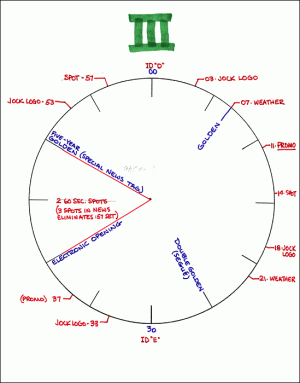What is the difference between the music director and the program director? The program director decides which records gets played on the air, correct? Or, the program director hires and fires the air talent? Does the music director work under the supervision of the program director?
I'm not sure if Music Director is even a thing any more. But back in the 60s and 70s, the Music Director, under the supervision of the Program Director, maintained the record library, dealt with the record promotion people (keeping them out of the Program Director's hair) , and listened to the incoming records.
The MD would also call a select group of local record stores to ask about sales of songs the station was playing or considering playing, and check the charts in Billboard, Record World, Cashbox, Radio & Records, The Gavin Report and others to see how songs were doing in other markets.
Depending on how closely the PD and the MD worked, the two would meet anywhere from once a week to daily to go over all that information and the new records the MD thought were most promising and discuss whether to add them the next time the playlist was updated (usually Tuesday or Wednesday at most stations I was familiar with in the 70s).
When those decisions were made for the week, the MD would call the promo reps whose records were selected and ask for duplicate copies for the library, call the promo reps whose records weren't selected to let them know whether their record was still under consideration for a possible add in the coming weeks, or whether (and this was always a good one to blame on the PD), there really wasn't any interest in discussing it further. The MD would also call the trade papers the station reported to to inform them of what records were added, dropped and had the biggest upward or downward movement that week.
Usually, it was up to the MD to put the physical copies of the new music into the studio, and adjust the categories of records whose upward or downward movement on the new chart had put them in a different category. If the radio station was still playing vinyl, that usually meant timing the record's intro and "posts" (points during the intro where there was some sort of punctuation---a drum hit, a bassline, a background vocal) and noting whether the record faded out or ended cold. A sticker would be put on the label of the record with that information. For example, with a song that had a :22 second intro but some punctuation at :09 and ended cold, the sticker would read ":09/:22/C". If the song faded, that "C" would be an "F" instead.
For stations that recorded their music onto tape cartridges, that would often be the MD's job too, unless union rules required it to be done by an engineer or member of the production staff.
After all that, it was usually up to the MD to type that week's chart, and either send it to the printer (at stations that had that professionally done) or make copies and mail them to the record label promotion people and the trade papers.
PDs were in charge of format clocks, contests and hiring and firing, though most station managers had veto power over money and personnel issues.


